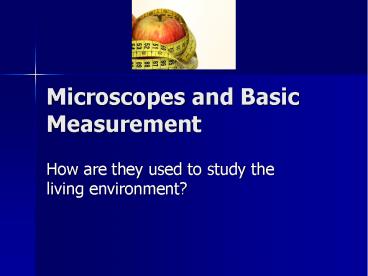Microscopes and Basic Measurement - PowerPoint PPT Presentation
Title:
Microscopes and Basic Measurement
Description:
Microscopes and Basic Measurement How are they used to study the living environment? Measuring and Units Use a standardized system (metric system) Meters = length ... – PowerPoint PPT presentation
Number of Views:294
Avg rating:3.0/5.0
Title: Microscopes and Basic Measurement
1
Microscopes and Basic Measurement
- How are they used to study the living environment?
2
Measuring and Units
- Use a standardized system (metric system)
- Meters length
- Gram mass
- Liter volume
3
Why Use Metric?
- Base 10 system
- Easier to convert units
- Simply multiply or divide by 10 to change unit
4
Prefixes
- Used to show smaller or larger measurements
- Mega
- Kilo
- Hecto
- Deka
- Deci
- Centi
- Milli
- Micro
- Nano
5
(No Transcript)
6
Important Unit for Microscopes
- Micrometers (microns) µm
- 1/1000th of a millimeter
- 1000 micrometers 1 mm
7
How Big is a Micron?
8
Early Microscopes
- Anton Van Leeuwenhoek (1670s)
- First to see and describe single celled organisms
(protozoa)
9
(No Transcript)
10
Robert Hooke (1665)
- Coined term cell
11
Earliest Microscope?
12
Parts of a Compound Microscope
13
- Contain two lenses that cause light rays to bend
in such a way to produce an enlarged image.
14
Lenses
- Ocular Lens eyepiece lens
- Objective Lens can be low, medium or high power
- Look at magnification on lens
- Lower power is smaller in size
15
Letting in Light
- Mirror or Illuminator directs light up through
the specimen - Diaphragm regulates amount of light
- Disk with different sized iris or openings
16
- Arm connects stage and body tube
- Stage platform with opening over which a
specimen is placed (clips to hold slide) - Base supports microscope
17
- Eyepiece (ocular) part you look through, holds
ocular lens, magnifies 10x - Body tube connects eyepiece objective lenses
- Nosepiece holds objective lenses (can be turned)
- Objective Lens magnifies image, can be low,
medium, high power
18
- Focusing
- Coarse Adjustment Knob
- use on low power only!!
- (never use with high power
- you can break your slide!)
- Fine Adjustment Knob
- once low power is focused
- switch to high power and use
- fine adjustment.
19
Magnification
- How much can you enlarge the image?
- Ex 100x 100 times as big
20
Finding Total Magnification
- Multiply strengths of two lenses you are using.
- Ocular lens x Objective lens
- Ex
- Ocular 10x
- High Power Objective 45x
- Total Magnification (10 x 45) 450x
21
Practice
- Find Total Magnification
- Ocular 2x, Objective 30x
- Ocular 10x, Objective 60x
- If Ocular is 10x and Total mag. 350x
- What is the strength of the objective lens?
22
- Note
- As you increase magnification you need to let in
more light to see your specimen (adjust diaphragm)
23
Resolution
- How sharp can you get the image?
- Ability of microscope to distinguish two objects
as being separate (ex one cell from another)
24
What Happens to Image?
- Compound Microscopes
- Image becomes inverted and upside down
25
What Happens to Image?
- When you increase magnification
- Object appears larger
- Field of view gets smaller
26
Finding Field of View (F.O.V)
- Under Low Power Use millimeter ruler
- Ex 1.5mm
- Convert to micrometers
- 1 mm 1000 micrometers
- So 1.5 mm 1,500 micrometers
- (Move decimal over 3 to right)
27
Finding Field of View (F.O.V)
- Under Medium or High Power
- Need to set up a proportion
- Remember!!
- As magnification increases FOV decreases
28
- Low power Magnification High power FOV
- High power Magnification Low power FOV
- Ex 100x HP FOV
- 500x 1500 micrometers
- 500x 150000
- HP FOV 300 micrometers
29
Determining the Size of an Object Under a
Microscope
30
- View and draw object on low power
- Estimate how many objects would fit across
diameter of field of view
31
- Divide the diameter of FOV by the number of
objects that can fit across it. - Ex
- Three letter es fit across FOV of 1800
micrometers - Each letter is about 600 micrometers
1800 micrometers 600 µm 3 letter e
32
Comparing Microscopes
33
- Compound Light Microscope
- Magnification 40x 1500x
- 2-D image, inverted, upside down
- Uses stains to see details (may kill specimen)
- Specimen must be thin to allow light through
34
- Dissecting Microscope
- Low mag. 10x 20x
- See true image (right side up)
- Specimen can be alive
- Can use tools for dissecting specimen
- Binocular (two ocular lens) so you can see 3-D
image
35
- Phase Contrast Microscope
- Uses special filters to show depth without
staining. - Can see interior details of living cells
36
- Electron Microscopes
- Much higher magnification and resolution than
microscopes that use light. - Magnifies up to 200,000x
- Uses beam of electrons
- Sample placed in vacuum
- Cannot view living specimens
- Allowed scientists to see structure of cellular
organelles
37
(No Transcript)
38
Other Equipment
- Centrifuge
- Separates cell components by density
- Whirls test tubes at high speed
- Heaviest at bottom
39
- Micro-dissecting Tools
- Used to dissect cells































